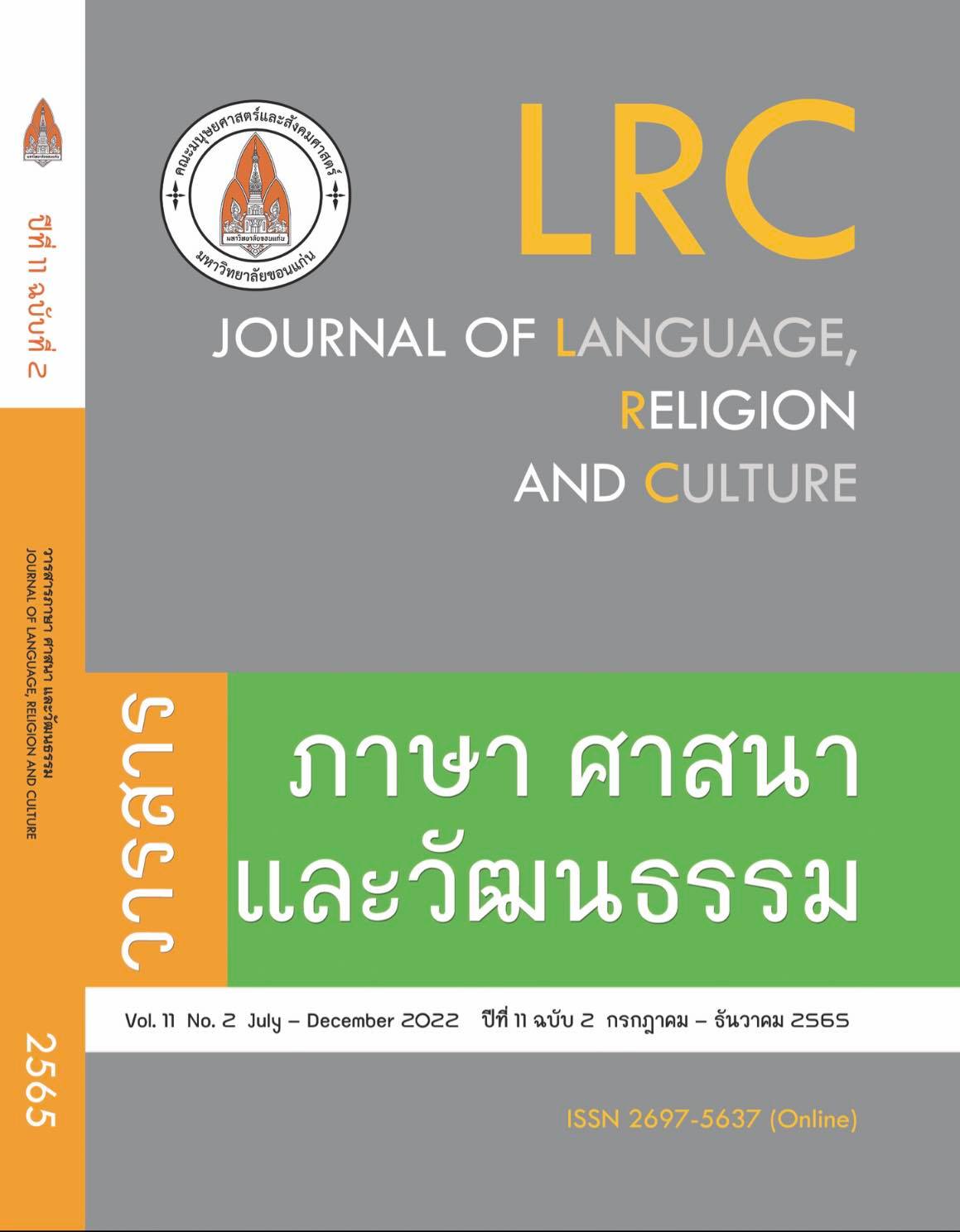การตีความเชิงอรรถศาสตร์ของโครงสร้างประโยคที่ประธานเป็น ผู้ถูกกระทำในบทความข่าวธุรกิจ
คำสำคัญ:
โครงสร้างประโยคที่ประธานเป็นผู้ถูกกระทำ, การตีความทางอรรถศาสตร์, บทความข่าวธุรกิจบทคัดย่อ
โครงสร้างประโยคที่ประธานเป็นผู้ถูกกระทำในการศึกษานี้อ้างถึงโครงสร้างประโยคที่ประธานเป็นผู้ถูกกระทำแบบพื้นฐาน (The business is now run by the former boss of the good guys) การศึกษาข้อมูลโครงสร้างประโยคที่ประธานเป็นผู้ถูกกระทำก่อนหน้านี้ให้ความสำคัญกับบทความวิชาการและตำราเรียน ในงานวิจัยนี้จึงนำเสนอโครงสร้างประโยคที่ประธานเป็นผู้ถูกกระทำจากมุมมองบทความข่าวธุรกิจ The New York Times ซึ่งเป็นหนังสือพิมพ์ของอเมริกา The Australian ซึ่งเป็นหนังสือพิมพ์ของออสเตรเลีย และ The Times of London ซึ่งเป็นหนังสือพิมพ์ของอังกฤษ จำนวนคำของการศึกษาโครงสร้างประโยคที่ประธานเป็นผู้ถูกกระทำแบบพื้นฐานในการศึกษานี้คือ 150,000 คำประกอบด้วย 515 ตัวอย่าง จำนวนทั้งหมดของตัวอย่างแยกได้เป็น 119 ตัวอย่างจากข่าวธุรกิจในหนังสือพิมพ์ของอเมริกา 245 ตัวอย่างจากข่าวธุรกิจในหนังสือพิมพ์ของออสเตรเลีย และ 151 ตัวอย่างจากข่าวธุรกิจในหนังสือพิมพ์ของอังกฤษ การวิเคราะห์ข้อมูลทำตามแบบอย่างของ Bielak, Pawlak & Mystkowska-Wiertelak (2013) ผลการศึกษาการตีความทางอรรถศาสตร์ของโครงสร้างประโยคที่ประธานเป็นผู้ถูกกระทำ ถูกใช้ในความหมายทางการพัฒนาโครงการใหม่ การจ้างงาน การโฆษณา การตีความที่เกี่ยวกับการเงิน และ ผู้มีอำนาจ การศึกษาโครงสร้างประโยคที่ประธานเป็นผู้ถูกกระทำในการศึกษานี้จะเป็นประโยชน์แก่ผู้เรียนภาษาอังกฤษเป็นภาษาที่สอง และผู้เรียนภาษาอังกฤษเป็น ภาษาต่างประเทศ
เอกสารอ้างอิง
Alvin, L. (2014). The passive voice in scientific writing: The current norm in science journals. Journal of Science Communication, 13(1): 1-16.
Arrese, J. (2009). Effective vs. epistemic stance, and subjective/ intersubjectivity in political discourse: A case study. Anastasio Tsangalidis and Roberta Facchinetti (eds.). Studies on English modality: In
honour of Frank Palmer. Germany: Peter Lang, 24-52.
Bada, E. & Ömer G. (2018). “Utilization of active and passive constructions in English academic writing”. Journal of Human Science, 15(1), 413-421.
Bakalar, T., Razusova M, Pavolove, H. & Hlavnova, B. 2014. “Use of active and passive forms in paper from the field of chemical engineering”. Communications, 3, 102-107.
Bielak, Jakub, Pawlak, M & Mystkowska-Wiertelak, A. 2013. “Teaching the English active and passive voice
with the help of cognitive grammar: An empirical study”. Studies in Second Language Learning and Teaching, 3(4), 581-619.
Biondi, C. (2002). Active versus passive sentence constructions: Which is the best choice?. American Communication Journal, 5(2),1-4.
Bonyadi, A. (2011). Linguistic manifestations of, modality in newspaper editorials. International Journal of Linguistics, 3(1), 1-13.
Boonpattanaporn, P. (2011). A comparative study of post modifiers used in business news in leading newspapers in Thailand, USA and UK. Thesis, University of Thai Chamber of Commerce.
Bratić, I. (2016). Stylistic differences in the use of passive voice in English Language. Zbornik radova Veleučilišta u Šibeniku, 3(4), 141-147.
Cox, F. & Palethorpe, S. (2012). Standard Australian English: The sociostylistic broadness continuum.
Raymond Hickey (ed). Standard of English: Codified Varied Around the World. Cambridge: Cambridge University Press, 294-317.
Chen, L. & Oller, J. 2008. The use of passives and alternatives in English by Chinese speakers”. Sabine De
Knop & Teun De Rycker (eds.). Cognitive Approaches to Pedagogical Grammar. New York: Mouton de Gruyter, 385-410.
Doláková, V. (2016). The passive voice in business English. Dissertation, Masaryk University.
Duboviciene, T & Skorupa O. (2017). Passive voice as a means of impersonal presentation of facts in English quality press. Svetimosios kalbos, 19(3), 38-47.
Dreschler, G. (2010). Topic introduction in the by-phrase: Long passives in Early Modern English”. Linguistics in the Netherlands, 59-72.
Henley, N., Miller M.& Beazley, J. (1995). “Syntax, semantics, and sexual violence agency and the passive voice”. Journal of Language and Social Psychology, 14(1-2): 60-84.
Hinkel, E. (2004). Tense, aspect and the passive voice in L1 and L2 academic texts. Language Teaching Research, 8(1), 5-29.
Leitber, G. (2013). Australian English-the national language. New York: Mouton de Gruyter.
Lirola, M. & Zammit, K. (2017). Disempowerment and inspiration: A multimodal discourse analysis of immigrant women in the Spanish and Australian online press”. CADAAD, 8(2), 58-79.
Marin-Arrese, J. (2008). “Commitment and subjectivity in the discourse of opinion columns and leading
article: A corpus study”. Isabel Alonso Belmonte (ed.). Different Approaches to Newspaper Opinion Discourse RAEL: revista electrónica de lingüística aplicada, 82-98.
McEnery, T. & Kifle, N. (2002). Epistemic modality in argumentative essays of second language writers. Academic Discourse, 182-195.
McEnery, T. & Xiao, R. (2005). Passive constructions in English and Chinese: a corpus-based contrastive study. Language in Contrast, 6(1), 109-149.
Minton, T. (2015). In defense of the passive voice in medical writing. The Keio Journal of Medicine, 1-10.
Munalim, L. & Gonong, G. (2019). Filipino student’s active-passive voice preference in invitation letters. The Normal Light, 13(1), 151-178.
Nordlinger, R. & Traugott, E. (1997). “Scope and the development of epistemic modality: Evidence from ought to”. English Language and Linguistics, 1(2), 295-317.
Oh, S. (2007). A corpus study of epistemic modality in Korean college students’ writing in English. English Teaching, 62(2), 147-175.
Omenogor, H. (2019). The use of the passive voice for diplomatic and polite formal Communications. Journal of Language and Literary, 1(5), 73-84.
Schueler, D. (2016). Factivity and complement-types. Studia Linguistica, 70(3), 297-335.
Smith, N & Rayson, P. (2007). “Recent change and variation in the British English use of the progressive passive”. ICAME Journal, 31, 129-159.
Stojan, N& Novak, S. (2017). Passive voice in political newspapers articles. PEOPLE: International Journal of Social Sciences, 3(2), 105-123.
Swan, M. (2016). Practical English Usage. Oxford: Oxford University Press.
Tangpijaikul, M. (2014). Preparing business vocabulary for ESP classrooms. RELC Journal, 45(1), 51-65.
Tewksbury, D. (2003). “What do Americans really want to know? Tracking the behavior of news readers on the internet. International Communication Association, 53(4), 694-710.
ดาวน์โหลด
เผยแพร่แล้ว
รูปแบบการอ้างอิง
ฉบับ
ประเภทบทความ
สัญญาอนุญาต
ลิขสิทธิ์ (c) 2022 วารสารภาษา ศาสนา และวัฒนธรรม

อนุญาตภายใต้เงื่อนไข Creative Commons Attribution-NonCommercial-NoDerivatives 4.0 International License.







